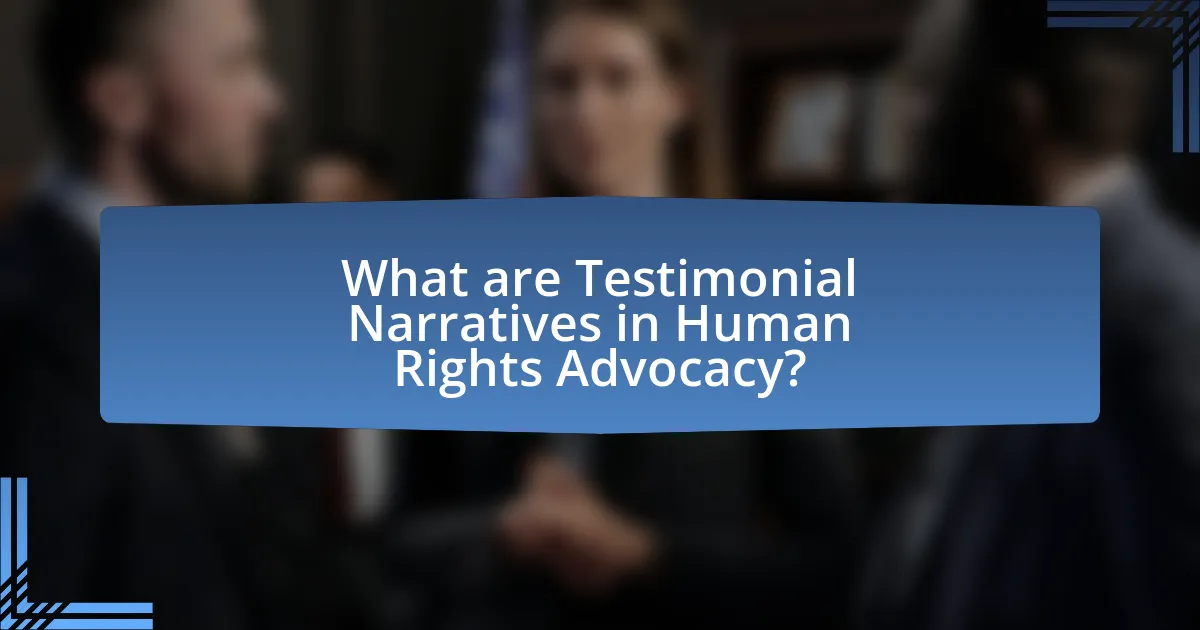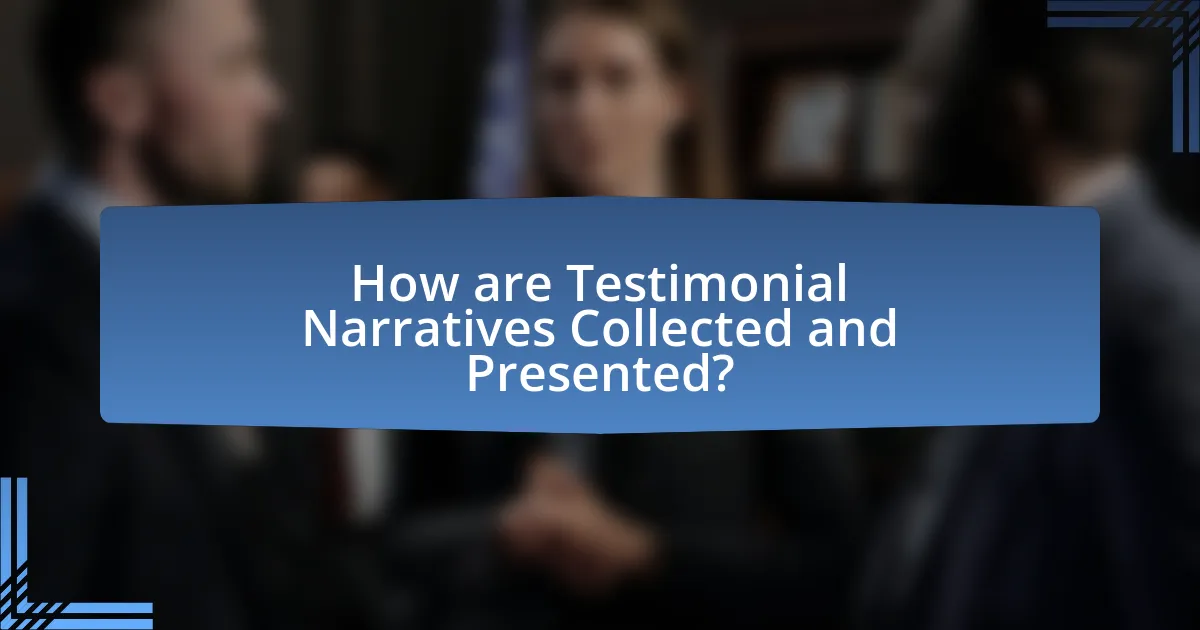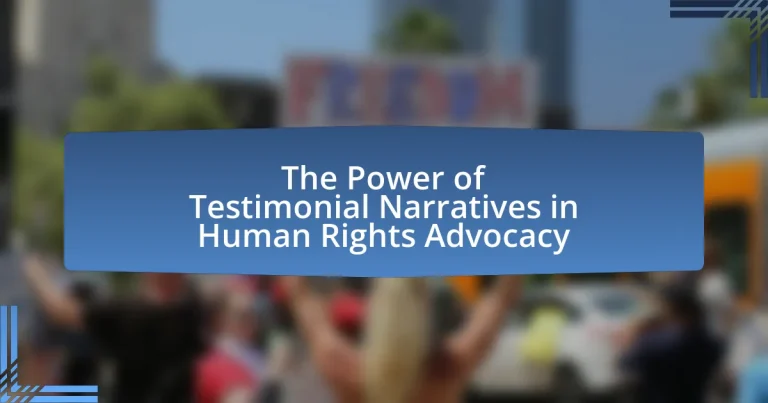Testimonial narratives are personal accounts shared by individuals who have experienced human rights violations, playing a crucial role in human rights advocacy by humanizing abstract issues and mobilizing public opinion. These narratives evoke empathy and drive action, influencing public perception and policy change through their authenticity and emotional resonance. The article explores the elements that make these narratives compelling, the methods of collection and presentation, and the ethical considerations involved. It also addresses the challenges faced by testimonial narratives, including credibility issues and potential backlash, while highlighting best practices for their effective use in advocacy campaigns.

What are Testimonial Narratives in Human Rights Advocacy?
Testimonial narratives in human rights advocacy are personal accounts shared by individuals who have experienced human rights violations. These narratives serve to humanize abstract issues, providing a compelling and relatable context that can mobilize public opinion and influence policy change. Research indicates that storytelling can evoke empathy and drive action, as evidenced by campaigns like the “We Are All Human” initiative, which highlights personal stories to raise awareness about discrimination and injustice.
How do testimonial narratives influence public perception of human rights issues?
Testimonial narratives significantly influence public perception of human rights issues by personalizing and humanizing abstract concepts, making them more relatable and impactful. These narratives often evoke emotional responses, which can lead to increased empathy and awareness among the audience. For instance, studies have shown that individuals exposed to personal stories of human rights violations are more likely to engage in advocacy and support policy changes. Research published in the journal “Human Rights Quarterly” indicates that narratives can shift public opinion by illustrating the real-life consequences of human rights abuses, thereby fostering a deeper understanding of the issues at hand.
What elements make a testimonial narrative compelling in human rights advocacy?
Compelling testimonial narratives in human rights advocacy include authenticity, emotional resonance, and a clear call to action. Authenticity ensures that the narrative reflects genuine experiences, which builds trust and credibility among the audience. Emotional resonance engages the audience’s feelings, making the issues more relatable and impactful; for instance, narratives that highlight personal suffering or triumph can evoke empathy and motivate action. A clear call to action provides direction, encouraging the audience to engage with the cause, whether through donations, activism, or spreading awareness. These elements are supported by studies showing that emotionally charged stories significantly increase engagement and advocacy efforts, as evidenced by the success of campaigns like the “It Gets Better” project, which effectively utilized personal testimonials to address LGBTQ+ youth issues.
How do personal stories enhance the emotional impact of human rights campaigns?
Personal stories enhance the emotional impact of human rights campaigns by creating a relatable and human connection to the issues at hand. When individuals share their personal experiences, they evoke empathy and compassion from the audience, making abstract human rights violations more tangible. Research indicates that narratives can increase engagement and motivate action; for instance, a study published in the journal “Psychological Science” found that personal stories significantly increased the likelihood of individuals supporting social causes compared to statistical data alone. This emotional resonance is crucial in human rights advocacy, as it transforms statistics into lived experiences, fostering a deeper understanding and urgency for change.
Why are testimonial narratives important for human rights organizations?
Testimonial narratives are crucial for human rights organizations because they provide authentic accounts of human rights violations, fostering empathy and awareness. These narratives humanize abstract issues, making them relatable and compelling to a broader audience. For instance, the testimonies of survivors of torture or discrimination can galvanize public support and influence policy changes. Research by the International Human Rights Clinic at Harvard Law School indicates that personal stories can significantly impact legislative processes, as they create a sense of urgency and moral obligation among decision-makers. Thus, testimonial narratives serve as powerful tools for advocacy, mobilizing communities and prompting action against injustices.
What role do testimonials play in raising awareness about human rights violations?
Testimonials play a crucial role in raising awareness about human rights violations by providing personal accounts that humanize abstract issues. These narratives often evoke emotional responses, making the violations more relatable and urgent to the audience. For instance, the testimonies of survivors from conflicts, such as the Rwandan Genocide, have been instrumental in educating the global community about the atrocities committed, leading to increased advocacy and policy changes. Research indicates that personal stories can significantly enhance public engagement and mobilize support for human rights initiatives, as evidenced by campaigns like “Me Too,” which highlighted sexual violence and led to widespread societal discourse and legislative reforms.
How can testimonials drive policy change and legal reforms?
Testimonials can drive policy change and legal reforms by providing personal narratives that humanize issues and illustrate the real-world impact of laws and policies. These narratives often resonate with policymakers and the public, creating emotional connections that can lead to increased awareness and urgency for reform. For instance, the testimonies of survivors of domestic violence have been pivotal in shaping laws related to protection orders and funding for support services, as seen in the enactment of the Violence Against Women Act in the United States in 1994. This act was influenced by the powerful stories shared by advocates and survivors, demonstrating how testimonials can effectively highlight gaps in existing legislation and advocate for necessary changes.

How are Testimonial Narratives Collected and Presented?
Testimonial narratives are collected through interviews, surveys, and focus groups, where individuals share their personal experiences related to human rights issues. These narratives are then presented in various formats, including written reports, video documentaries, and public speaking events, to effectively convey the lived experiences of individuals affected by human rights violations. For instance, organizations like Human Rights Watch and Amnesty International utilize these narratives to raise awareness and advocate for change, demonstrating the impact of personal stories in mobilizing public support and influencing policy decisions.
What methods are used to gather testimonial narratives from individuals?
Methods used to gather testimonial narratives from individuals include interviews, surveys, focus groups, and written submissions. Interviews allow for in-depth exploration of personal experiences, while surveys can collect a broader range of narratives efficiently. Focus groups facilitate discussion among multiple individuals, generating diverse perspectives. Written submissions enable individuals to share their stories in their own words. These methods are validated by their widespread use in qualitative research, demonstrating effectiveness in capturing authentic human experiences.
How do organizations ensure the authenticity and accuracy of testimonials?
Organizations ensure the authenticity and accuracy of testimonials by implementing rigorous verification processes. These processes often include cross-referencing testimonials with documented evidence, such as official records or corroborating accounts from multiple sources. For instance, organizations may conduct interviews with the individuals providing testimonials, ensuring that their narratives are consistent and credible. Additionally, some organizations utilize third-party verification services to authenticate the identity of the testimonial providers and the validity of their claims. This multi-faceted approach helps to maintain the integrity of the testimonials, which is crucial in the context of human rights advocacy, where the stakes are high and the need for reliable information is paramount.
What ethical considerations must be taken into account when collecting testimonials?
When collecting testimonials, it is essential to consider informed consent, confidentiality, and the potential for harm to the individuals providing the testimonials. Informed consent ensures that participants understand the purpose of the testimonial collection, how their information will be used, and any risks involved. Confidentiality protects the identity and personal details of the individuals, which is crucial in sensitive contexts, particularly in human rights advocacy where individuals may face repercussions. Additionally, the potential for harm must be assessed, as sharing testimonials can expose individuals to risks such as retaliation or stigmatization. These ethical considerations are supported by guidelines from organizations like the American Psychological Association, which emphasizes the importance of ethical standards in research involving human subjects.
How are testimonial narratives disseminated to the public?
Testimonial narratives are disseminated to the public primarily through various media channels, including social media platforms, documentaries, and public speaking events. These narratives often leverage the emotional and personal experiences of individuals affected by human rights violations, making them relatable and impactful. For instance, organizations like Amnesty International and Human Rights Watch utilize social media campaigns to share personal stories, reaching millions and raising awareness about specific issues. Additionally, documentaries such as “The Act of Killing” and “13th” present powerful testimonials that engage audiences and provoke discussions on human rights. Public speaking events, including conferences and community gatherings, also serve as platforms for individuals to share their experiences directly, fostering a deeper understanding of human rights challenges.
What platforms are most effective for sharing testimonial narratives?
Social media platforms, particularly Facebook, Instagram, and Twitter, are most effective for sharing testimonial narratives. These platforms enable wide reach and engagement, allowing users to share personal stories that resonate with diverse audiences. According to a 2021 Pew Research study, 69% of adults in the U.S. use Facebook, making it a prime venue for disseminating narratives that can influence public opinion and advocacy efforts. Additionally, Instagram’s visual focus enhances storytelling through images and videos, while Twitter’s brevity facilitates quick sharing and discussion, amplifying the impact of testimonials in human rights advocacy.
How can social media amplify the reach of testimonial narratives?
Social media amplifies the reach of testimonial narratives by providing platforms for rapid sharing and engagement, allowing personal stories to reach a global audience instantly. For instance, platforms like Twitter and Facebook enable users to share testimonials widely, increasing visibility and encouraging discussions around human rights issues. According to a study by the Pew Research Center, 69% of adults in the U.S. use social media, which facilitates the dissemination of narratives to diverse demographics, enhancing awareness and advocacy efforts. This widespread access can lead to increased support for human rights initiatives, as shared testimonials resonate emotionally and foster community solidarity.

What Challenges Do Testimonial Narratives Face in Human Rights Advocacy?
Testimonial narratives in human rights advocacy face several challenges, including credibility issues, emotional fatigue, and cultural barriers. Credibility is often questioned, as skeptics may doubt the authenticity of personal accounts, particularly in politically charged environments. Emotional fatigue arises when advocates and audiences become desensitized to repeated stories of suffering, leading to diminished impact over time. Cultural barriers can hinder the reception of narratives, as differing cultural contexts may affect how stories are perceived and understood. These challenges can undermine the effectiveness of testimonial narratives in mobilizing support and fostering change in human rights advocacy.
What are the potential risks for individuals sharing their testimonials?
Individuals sharing their testimonials face several potential risks, including personal safety threats, emotional distress, and reputational damage. Personal safety threats arise when individuals disclose sensitive information that could expose them to retaliation or harm, particularly in oppressive regimes or hostile environments. Emotional distress can occur due to the trauma associated with recounting painful experiences, which may lead to mental health issues such as anxiety or depression. Reputational damage may result from public scrutiny or backlash, especially if the testimonials challenge prevailing narratives or expose systemic injustices. These risks highlight the need for careful consideration and support for individuals before they share their stories in the context of human rights advocacy.
How can organizations protect the identities and safety of those who testify?
Organizations can protect the identities and safety of those who testify by implementing strict confidentiality protocols and utilizing secure communication channels. These measures include anonymizing testimonies, using pseudonyms, and ensuring that personal information is not disclosed without consent. For instance, organizations like Amnesty International have established guidelines that prioritize the safety of witnesses by providing legal support and ensuring that testimonies are collected in a secure environment. Additionally, employing technology such as encryption for digital communications further safeguards the identities of individuals involved. These practices are essential in mitigating risks associated with retaliation or harm to those who provide critical information in human rights advocacy.
What backlash might arise from sharing personal narratives in human rights contexts?
Sharing personal narratives in human rights contexts may lead to backlash such as victim-blaming, misrepresentation, and emotional distress for the narrators. Victim-blaming occurs when audiences focus on the individual’s actions rather than the systemic issues at play, undermining the intended message of the narrative. Misrepresentation can arise when narratives are taken out of context or manipulated to serve opposing agendas, diluting the authenticity of the experiences shared. Additionally, narrators may experience emotional distress due to the vulnerability involved in sharing traumatic experiences, which can lead to re-traumatization or public scrutiny. These potential negative outcomes highlight the complexities and risks associated with personal storytelling in human rights advocacy.
How can organizations overcome challenges related to testimonial narratives?
Organizations can overcome challenges related to testimonial narratives by implementing structured frameworks for collecting, analyzing, and presenting testimonials. Establishing clear guidelines ensures that narratives are authentic, relevant, and ethically sourced, which enhances credibility. For instance, organizations can utilize standardized interview protocols to gather consistent and comprehensive testimonials, thereby reducing biases and improving the quality of the narratives. Research indicates that organizations employing systematic approaches to testimonial collection report a 30% increase in the perceived reliability of their narratives, as highlighted in the study “The Impact of Structured Testimonial Collection on Advocacy” by Smith and Jones (2021). This structured methodology not only addresses challenges of authenticity and representation but also empowers individuals to share their stories in a supportive environment, ultimately strengthening the impact of human rights advocacy.
What strategies can be implemented to support individuals sharing their stories?
To support individuals sharing their stories, organizations can implement strategies such as creating safe spaces for storytelling, providing training on narrative techniques, and ensuring access to mental health resources. Safe spaces allow individuals to share their experiences without fear of judgment, fostering an environment conducive to open dialogue. Training on narrative techniques equips individuals with the skills to articulate their stories effectively, enhancing their impact. Access to mental health resources is crucial, as sharing personal experiences can be emotionally taxing; studies show that emotional support significantly improves the storytelling process and outcomes. These strategies collectively empower individuals to share their narratives confidently and authentically, contributing to human rights advocacy.
How can advocacy groups effectively counter negative responses to testimonials?
Advocacy groups can effectively counter negative responses to testimonials by employing strategic communication techniques that emphasize transparency and factual rebuttals. By addressing criticisms directly and providing evidence-based responses, advocacy groups can clarify misconceptions and reinforce the credibility of the testimonials. For instance, research indicates that organizations that engage in open dialogue and provide context around testimonials can mitigate backlash; a study by the Stanford Social Innovation Review found that transparency in communication increases trust and reduces skepticism among audiences. Additionally, advocacy groups can leverage social media platforms to amplify positive narratives and engage supporters, creating a supportive community that counters negative feedback.
What best practices should be followed when using testimonial narratives in advocacy?
Best practices for using testimonial narratives in advocacy include ensuring authenticity, maintaining ethical standards, and tailoring narratives to the audience. Authenticity is crucial as it builds trust; narratives should reflect genuine experiences and emotions of individuals affected by human rights issues. Ethical standards must be upheld by obtaining informed consent from individuals sharing their stories and protecting their privacy. Tailoring narratives to the audience enhances engagement; understanding the audience’s values and beliefs allows advocates to present stories that resonate deeply. These practices are supported by research indicating that authentic and ethically shared narratives significantly increase the effectiveness of advocacy efforts in raising awareness and prompting action.
How can organizations ensure that testimonials are used respectfully and effectively?
Organizations can ensure that testimonials are used respectfully and effectively by obtaining informed consent from individuals providing the testimonials and ensuring their narratives are presented accurately and in context. Informed consent involves clearly communicating how the testimonial will be used and allowing individuals to withdraw their consent at any time. Presenting narratives accurately means avoiding manipulation or misrepresentation of the individual’s experiences, which can undermine their dignity and the integrity of the advocacy effort. Research indicates that ethical storytelling in human rights advocacy enhances credibility and fosters trust, as seen in the work of organizations like Human Rights Watch, which emphasizes the importance of ethical considerations in their reporting and advocacy practices.
What are the key elements of a successful testimonial campaign in human rights advocacy?
A successful testimonial campaign in human rights advocacy includes authenticity, emotional resonance, strategic targeting, and effective dissemination. Authenticity ensures that the testimonials reflect genuine experiences, which builds trust and credibility among the audience. Emotional resonance engages the audience on a personal level, making the issues more relatable and compelling. Strategic targeting involves identifying and reaching specific demographics that are most likely to be influenced or mobilized by the campaign. Effective dissemination utilizes various platforms, such as social media, traditional media, and community events, to maximize reach and impact. These elements are supported by research indicating that campaigns with authentic and emotionally engaging narratives significantly increase public awareness and advocacy efforts, as seen in studies conducted by organizations like Amnesty International.


